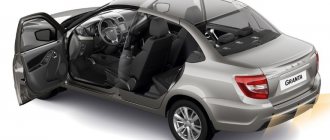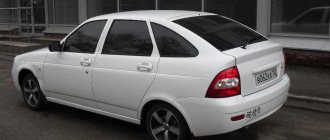The interior of the Lada Granta has undergone many changes and has significant differences from its predecessors (Kalina and Samara). So there is no need to talk about earlier cars in the line, although there are external similarities with these models.
It was Granta that became VAZ’s successor to the traditions of the model range and is available in the classic three types of configuration: Norma, Standard and Luxury. The parameters of the Lada Granta automatic correspond to the basic configuration of the Norma and Luxury models of the Granta line. In general, the new Lada is characterized by compliance with modern comfort requirements. While there are some similarities with Kalina, it can be noted that Granta is already a higher level of convenience in the cabin.
Interior comfort
The dimensions of the new Lada are such that they can comfortably fit five passengers in the cabin. The rear seats have sufficient freedom. The height of the car does not make it difficult for a person of above average height to sit comfortably.
Analyzing the interior in more detail, you can see that a positive impression of being inside the Lada Granta is created due to numerous improvements. However, no excessive bends or lines are noted. For basic configurations (Lada Granta Standard and Norma) of domestic cars, such forms are appropriate.
Innovation also includes the designers' idea for a torpedo of an updated design. There is a minimal number of connections on it, which eliminates various creaks and other extraneous sounds noted in its predecessors. It is made of high quality plastic, resistant to fading and providing an additional level of noise and vibration insulation. Sound insulation is generally much better, but leaves much to be desired. The door panels are equipped with fewer parts, which guarantees the absence of sounds during movement.
Simplicity and conciseness are the key to travel comfort
Sergey Znaemsky tested the Lada Granta with a Jatco automatic transmission: how does it drive?
I saw the steam locomotives on the site of the VAZ Technical Museum - and it clicked in my head: you couldn’t find a better backdrop for a portrait of Granta with a machine gun! He grabbed the phone and began calling the administration, begging them to let the car into the closed area. On Saturday. In the evening. Luckily, VAZ top engineer Oleg Grunenkov had an “all-terrain vehicle” pass with access to any corner of AvtoVAZ. But Oleg sighed doomedly: “Once again it turns out that Granta is archaic, like a steam locomotive, with the same efficiency...
The invitation letter arrived at the editorial office in early July, and it said that acquaintance with the “automatic” Granta would take place in Togliatti in the middle of... June! I didn’t have time to figure out who exactly was a month late - the VAZ team or the email, because right there in the event program I discovered even more intriguing dates: departure from Moscow - May 19, return - July 22. Two months in Togliatti?
The matter, of course, turned out to be banal typos: the first commercial Ladas with automatic transmissions rolled off the VAZ assembly line on July 19 of this year.
- Get ready! Our car will go through five bodies!
Under the hood, the gearbox is located traditionally, to the left of the engine. The “automatic” is 33 kg heavier than the “manual”, and 33 new parts appeared in the car itself, so the weight of the Grant increased by 45 kg and the front springs had to be made a little stiffer. The engine mounts were strengthened, the front suspension stretch on the left side was changed, and a new radiator was installed. The external CV joints on the “automatic” Grant are the same as on cars with “mechanics”, and the joints connecting the drive shafts to the gearbox are Tripod type (they have larger working angles). The automatic has a final drive with a ratio of 4.08. The transmissions on the Grants will be filled with Nissan Matic S fluid. The electronic transmission control unit is located in the wheel arch under the left front headlight. To ensure reliability, the Japanese put forward a requirement to increase the rigidity of the power unit - there are now not four, but six mounting points between the engine and transmission. For the same reason, the VAZ engine has a new cast pan. And the box itself has a stamped pallet. This is precisely the lowest point: the ground clearance was reduced to 140 mm and during testing, the VAZ team, having hit a boulder, still broke one box. There is no factory protection for the engine compartment, except for a plastic boot.
VAZ workers were fussing, reporters were crowding, assemblers were trying to get into work places. And now, across the expanses of the Kalinovsky assembly shop, a silver Grant floats onto the core of the assembly line. Under camera flashes, a 1.6 six-valve engine with a docked hydromechanical transmission from the Japanese company Jatco was brought up to it.
Engine compartment - bottom view
Box control unit
0 / 0
The technological term “marriage,” which is commonly used to describe the connection of a body with a power unit, has always given rise to piquant associations, and this case is no exception. Firstly, in the matter of introducing the “automatic”, AvtoVAZ itself, by all indications, acted rather in the role of a bride, and secondly, the morning after the ceremony, the Volzhsky Automobile Plant officially celebrated its birthday: the young man turned forty-six. Is a Lada with an automatic transmission a belated woman's happiness?
While automatic Grants are moving along the conveyor belt at long intervals, by the end of August they will only make a batch for dealer showrooms. By the beginning of next year, 10 thousand cars should be assembled, and next year - already 70 thousand, that is, every seventh Lada produced will be equipped with an automatic transmission. But Grants will be in the minority among these cars - the role of the main “car carrier” will go to the prettier new Kalina. But Granta is the most affordable car with an automatic transmission on the Russian market!
“ZAZ Chance and Chery Indis are not our competitors,” assures Oleg Khromkov, who led the introduction of Japanese automatic transmission at VAZ. — The “Chinese” has a “robot”, and it pulls, and Chance is almost 50 thousand more expensive.
At VAZ they say that without Oleg Khromkov there would be no “automatic”. A graduate of the Kuibyshev Aviation Institute (now Samara Aerospace University), Khromkov in the late 80s was engaged in calibrating engines for toxicity at VAZ and working on sports cars, but in 2006 he set out on his own and “swimmed” to the position of director of SeAZ. And three years ago he returned and headed the work on integrating the Japanese transmission. Based on his vocabulary, his command of English, and even his ability to choose a dress code, one gets the impression that Khromkov is one of some new breed of VAZ specialists
The Lada Granta for 373 thousand 300 rubles has a hydromechanical four-speed automatic transmission model JF414E, the oldest and simplest of those that Jatco offers for engines with a displacement of more than one liter. True, the transmission has recently undergone modernization, but still only two cars in the world are equipped with this transmission - our Granta and the Chinese-assembled Nissan March (aka Micra). VAZ doesn’t hide the fact that to make it cheaper, they chose a simpler transmission, and the fact that the design is not new can be regarded as a guarantee of reliability.
In the summer of 2010, when VAZ finally realized that the “automatic” needed to be launched either now or never again, the short list of candidate boxes, in addition to the Jatco unit, included Logan’s “automatic” DP0, as well as the FT702 transmission from the Moscow company KATE. The same “innovative” seven-speed planetary transmission without a torque converter, which for the last five years Maxim Nagaytsev, former vice-president of AvtoVAZ, current head of NAMI, and part-time co-investor of KATE, promised to launch into series. One Kalina with such an “automatic” even took part in evaluation tests: the power unit showed a tendency to overheat, and that was the end of it. Moreover, VAZ workers say that there was no real deadline for completing work on this box.
The French “automatic” was rejected because, at a similar cost, it was even less modern than the Japanese one.
The 2010 Jatco JF414E automatic transmission is the result of the only modernization of the four-speed gearbox that first appeared on the Nissan Sunny in 1989. Over 22 years, more than 11 million of these transmissions have been produced. The modernization did not affect the architecture: the use of new materials and technologies made it possible to reduce the body length by 11% and make the unit 15% lighter
By the way, Jatco offered AvtoVAZ a new generation X-tronic variator, but it turned out to be 20% more expensive than a hydromechanical transmission, although it provides a gain in fuel consumption of 1 l/100 km. The variator was postponed for the future. Grant's automatic transmission does not have sports or winter modes, nor does it have the ability to change gears manually. But the plastic on the handle is elastic and pleasant, there is a leatherette “apron” and the selector moves with noble effort. In general, there is no shame. And if you remember the “poker” of Logan’s “automatic machine”... On the other hand, in Grant’s plastic furniture, the lever of the new transmission looks like a Faberge egg at a roadside market.
The design of the transmission selector is VAZ, but the supplier is foreign. The lever is higher than that of the “mechanics”, the strokes are small, the groove is straight and it’s easy to miss the Drive position, especially if you’re not used to it. In positions 1 and 2, the transmission limits shifts above the indicated gears. On the left at the base there is an “overdrive off” button - disabling fourth gear
Although there is already air conditioning and a passenger airbag. In addition to them, especially for the version with an automatic transmission, ABS and all sorts of little things like ceiling handles for rear passengers have been added to the standard Norma equipment. There is no radio, however.
Corporate communication in Togliatti style - right during the journalistic presentation, AvtoVAZ Vice President for Sales and Marketing Artem Fedosov (left) convinces the head of Jatco in Russia Tadashi Yasuda (right) to organize the collection of “warranty” boxes through VAZ’s subsidiary Lada-Service
For now, all automatic Grants will be produced only in this expanded Norma Plus configuration. The Luxury version will appear later - there will be “music”, and with a multimedia screen, and a “color” instrument panel, and a stabilization system.
AvtoVAZ outlined the “consumer value” of an automatic transmission at 35 thousand rubles, so we can safely estimate that the luxury Granta will cross the threshold of 400 thousand rubles. Kalina with an automatic transmission will be even more expensive. Priora? Implanting an “automatic machine” into its outdated design would be too expensive - it will only receive it with a future change of generations.
“I have seven meetings per working day.” Oleg Grunenkov started as an ordinary designer, and at the age of forty he became the head of the most important projects for the company: Kalina, Granta, Datsun. Grunenkov is also one of the “new” VAZ top engineers - he takes a sober look at AvtoVAZ products, is savvy on economic issues and says that on his own initiative he went to study for an MBA course
AvtoVAZ spent little to “marry” the automatic transmission with its own engine: about 17 million euros. The contract with Jatco is for three years with the right to extend; the Japanese will supply fully assembled transmissions to AvtoVAZ from a plant in Fuji. If the question of their production in Russia arises, it will be provided that sales exceed 100 thousand cars per year. In the meantime, the Japanese company has only opened a representative office in our country.
Responsible for cooperation with AvtoVAZ and therefore now living in Tolyatti, Tadashi Yasuda, when asked what was the most difficult thing in working on the VAZ project, answers this way: to satisfy the needs of local consumers.
While setting up the transmission, the VAZ team turned to the Austrian company AVL for help. The starting point was the automatic transmission on the Nissan Note hatchback. But the “relaxed” Japanese calibrations, which were initially proposed by Jatco and AVL, did not suit the VAZ team.
“The response to the pedal, the operation of the box when starting off - everything turned out smoothly, like on an electric locomotive,” explains Khromkov. — The difference in driving philosophy and mentality! They drive small budget cars slowly, but here...
And for Granta and Kalina with automatic transmissions, we have specially selected the most powerful possible engine - a 98-horsepower sixteen-valve VAZ-21126 with a lightweight connecting rod and piston group. With the support of the Austrians from AVL, the VAZ team adapted the automatic calibrations in their own way: as they say, “to suit the driver’s driving philosophy.” And, presumably, it was not without reason that journalists were released onto the karting track ring for the first trip.
It was then, I think, that Yasuda-san understood everything about the needs of local consumers, especially after one of the journalists took him for a ride as a passenger - senselessly and mercilessly, with the handbrake, with smoke coming from under the wheels... I bet: getting out from the car, the green-faced Japanese was thinking precisely about the difference in mentalities.
“As if we wouldn’t have to look for an alternative supplier,” VAZ engineers joked behind their backs.
The bar with the automatic mode symbols near the lever is not illuminated, so the only visual indication of the transmission’s operation is in the upper right corner of the display on the instrument panel. Both the transmission mode and the number of the gear used are reflected here. By the way, the Japanese gearbox has what VAZ people call “virtual fifth gear.” The bottom line is that if in fourth gear and a speed above 50 km/h the driver begins to accelerate at half pedal, the box does not go down, but remains in top gear and briefly unlocks the torque converter to increase torque. The car drives as if with the clutch half depressed - this is noticeable only by the tachometer needle, which jumps by almost 1000 rpm
The bar with the automatic mode symbols near the lever is not illuminated, so the only visual indication of the transmission’s operation is in the upper right corner of the display on the instrument panel. Both the transmission mode and the number of the gear used are reflected here. By the way, the Japanese gearbox has what VAZ people call “virtual fifth gear.” The bottom line is that if in fourth gear and a speed above 50 km/h the driver begins to accelerate at half pedal, the box does not go down, but remains in top gear and briefly unlocks the torque converter to increase torque. The car drives as if with the clutch half depressed - this is noticeable only by the tachometer needle, which jumps by almost 1000 rpm
0 / 0
I started Granta with caution - my arms and legs still remembered the sedan in the Standard configuration, which we recently had at our editorial office for a “fitting”.
I started it, drove off and realized: “automatic”, air conditioning and power steering - here it is, a simple formula for a humane Lada. The Jesuit “ten-wheel mechanics” disappeared, many of the controls with which the driver came into contact changed, and Granta blossomed. And let the VAZ drivers not be modest: they say, “simpler and cheaper” - even on famous foreign cars, the rare hydromechanical “automatic” is configured as nicely as on the Lada!
In response to the first light press of the accelerator, the car starts moving without delay, then vigorous acceleration, logical soft transitions up and fast, without hesitation, down. The performance of the power unit when driving in the city is almost exemplary. Even though the dynamics have suffered and instead of 11.6 seconds, acceleration to hundreds takes 13.5 seconds, now these seconds still fly by, and do not drag on painfully.
The front suspension springs here are a little stiffer than on a regular Grant - the car is 45 kg heavier, but this has practically no effect on driving comfort. The suspension swallowed all the potholes, and still swallows, and the interior, as if it had all the guts of the front panel, still does.
Peppy both in the middle and at the top, the sixteen-valve engine is relatively quiet only up to 4500 rpm. It’s easy to comfortably maintain a speed of 120 km/h with it, but it comes out with a war cry for every intense overtaking.
I still don’t want to accelerate over 130 km/h. With both a short steering rack (3.1 turns from lock to lock) and ABS, the Grant chassis remained sagging and had sluggish brakes. A new vacuum booster with an “additional brake booster”, which increases the pressure in the system as it slows down, gave the brake pedal a thoroughbred rigidity, but the brake mechanisms themselves did not change. As a result, you have to press the pedal harder, but the Grant slows down just as reluctantly, and the ABS kicks in much later than the moment the wheels lock.
Oleg Grunenkov, who supervises all work on Kalina and Grant, says that all the problems are familiar to him and that next year the Grant chassis will be modernized. The brakes will be strengthened, the electric booster will be adjusted (to get rid of the void in the “zero”), and modified springs, shock absorbers and stabilizers will appear in the suspension.
Reliability? The standard service life of the “machine gun,” according to the Japanese, is ten years. But the factory warranty for such a Granta with automatic transmission is the same as for cars with manual transmission: three years or 50 thousand kilometers. The transmission cannot be repaired at dealership centers - equipment and training of servicemen require money and time, so at first AvtoVAZ will replace the defective gearboxes entirely, and Avtoframos will restore them. It looks like it will be done in the near future: by the end of the day, my car from the pilot series began to howl in second gear and tremble slightly at idle.
But still.
Three hundred seventy-three thousand rubles is less than for a Priora with a “mechanics” in a similar Norma configuration. At the same time, Granta is the first VAZ car in a long time that does not justify itself by being cheap, but seems to promise the buyer a good deal. This is the first Lada worthy of its price.
And not only Lada.
The Granta with an automatic transmission is almost like a Datsun sedan, which we will start selling in 2014. Nissan didn't just buy the rights to the VAZ platform - they borrowed the car almost entirely.
Air conditioning, passenger airbag, ABS and other delights of the Norma Plus package, alas, did not change the Granta’s interior much. The Luxury version is promised at the end of the year
A year and a half before the Grant appeared, Nissan adopted a strategy according to which budget cars should be developed not globally, but locally - using production sites and technical resources of the countries to which they are targeted. In Russia, the Japanese then incognito purchased five Kalinas, which were sent to England for testing. The result was devastating - handling, brakes, noise and vibration... But the summary stated that after modifications, the AvtoVAZ platform could be used to produce Nissan cars. The Japanese asked Tolyatti for a development strategy - and the VAZ team showed Nissan their Grants project.
The same Grunenkov is now leading the development of Datsun. The car will have Japanese decorative elements in the front and rear, and almost all the equipment will be ours, including the body, chassis and even engines. It was decided to install the VAZ eight-valve engine with manual transmission on the base Datsun, and the same sixteen-valve VAZ-21126 with a Jatco automatic transmission, as on the Grant and Kalina, on the more expensive version.
I say: “Datsun” - and Grunenkov’s eyes light up in a way that the VAZ team didn’t light up after the French from Renault appeared in Togliatti.
— Working with the Japanese is very interesting! French partners from Renault are strong in marketing, planning, and working with suppliers. And the Nissan team captivates with its approach to engineering. We are gaining enormous experience.
I listen to Grunenkov and it’s like I’m putting together a big VAZ puzzle. It becomes clear why the issue with the “automatic machine,” which the factory could not remove for decades, was suddenly resolved in just two years. And why was this particular “automatic” chosen? And even why my invitation included three different dates!
Having “hooked” Nissan, Granta pulled the entire plant along with her.
It was the Japanese who essentially lobbied for the choice of an automatic transmission from Jatco, which is 75% owned by Nissan. And Jatco itself, in turn, set the pace of work on the “automatic” Grant - 16 months.
True, VAZ did not believe that the “automatic” would be ready on time. Both the press service and even top managers, according to the old tradition, were counting on a delay and were waiting for a finished car with an automatic transmission in August or September. And Oleg Khromkov’s team completed the project in July, only four days behind schedule.
Other programs have also been shaken up. Since the automatic transmission is ready, there is no point in delaying the launch of the updated Kalina, for which the transmission was selected. There is no place to further delay the introduction of the VAZ-2180 manual gearbox with cable drive, which should have appeared two years ago (AR No. 9, 2010), the modernization of the Grant chassis is just around the corner...
As we know, the experience gained in the past cooperation with Porsche was enough for the VAZ team for three decades. And Nissan is going to de jure become a co-owner of AvtoVAZ in the near future - through a newly formed joint venture with the Russian Technologies company, the Japanese will get 15% of the capital. And it seemed to me that this merger was perceived at the plant as recognition. Not as a threat to identity, but as hope for it. Like a ticket to the future.
A locomotive—that’s what I was thinking about when I brought Lada to the locomotive. Well, the fact is that in the VAZ museum there was no more modern model... Maybe someday, for example, a Sapsan train will appear among the exhibits - then I’ll definitely take a photo of the next new Lada against its background. Or Datsun.
Photo of the new Lada Granta liftback
Granta liftback 2022 New Granta liftback Photo Granta liftback 2018 Granta liftback from behind Granta liftback from the front Granta liftback photo Granta liftback from behind photo Photo Granta liftback 2018
Now the Lada Granta 2022 model year can also boast of a station wagon. Without this type of body, the model range cannot be called complete. Especially in our country, where there are millions of practical summer residents. In the exterior of the Kalina universal body, only the front part is new. At the same time, the hood and fenders have the same shape, so there will be no problems with spare parts from a tin. If there is a station wagon, then there must be an off-road option. So it is that in the near future Russians will be able to please themselves with a modification of the Lada Granta Cross. The off-road station wagon will appear at dealers a little later than other models. Photos of Granta SW Cross are attached.
Photos of the new Lada Granta sedan
Granta sedan photo 2022
New Granta sedan
Granta sedan front
Granta sedan from behind
Photo of Grants from behind
Trunk Granta sedan
Granta sedan 2018
New Lada Granta
The new Granta hatchback was created from Kalina by replacing a minimum of parts. Changes can only be found at the front, these are the optics, bumper and radiator grille. The rear is the same Kalina, neither the lights nor the bumper were changed. But still the Lada Granta hatchback model looks pretty good.
Photo of the new Lada Granta hatchback
Grant hatchback
New Granta hatch
Photo of Grant hatchback
Grant hatchback side view
Grant hatchback from behind
Granta hatchback 2018
Granta hatch 2018 photo
Lada Granta hatchback
The liftback received a new general face, the so-called x-face. The rest of the body was not changed; it already has a cool shape. This budget coupe is cheap. Let's look at photos of the updated version of Lada Granta Liftback 2022.











